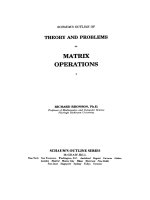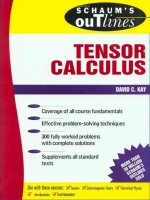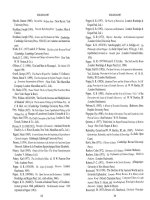schaum s easy outline of principles of economics based on schaum s outline of theory and problems of principl phần 8 pps
Bạn đang xem bản rút gọn của tài liệu. Xem và tải ngay bản đầy đủ của tài liệu tại đây (270.32 KB, 15 trang )
tween what she would be willing to pay for AF units of the commodity
(the area of AGCF) and what she actually pays for them (the area of
ABCF) is an estimate of this consumer’s surplus (the area of triangle
BGC).
True or False Questions
1. The demand curve is downward sloping because of the substitu-
tion and income effects.
2. The more of a commodity is consumed, the higher is the total util-
ity derived.
3. The law of diminishing marginal utility states that each successive
unit of the commodity consumed leads to a larger addition to total utili-
ty.
4. Consumer utility maximization is satisfied by the condition that
MU
x
= MU
y
= MU
z
.
5. Consumer’s surplus can be measured by the area under the de-
mand curve and below the commodity price.
Answers: 1. True; 2. True; 3. False; 4. False; 5. False
Solved Problems
Solved Problem 11.1 Suppose that a consumer has the MU
x
and MU
y
of Table 11.3, money income of $10, P
x
= $2, and P
y
= $1.
a. Describe how this consumer should spend each dollar of her $10
100 PRINCIPLES OF ECONOMICS
Figure 11-1
to purchase each unit of X and Y so as to maximize her total utility or sat-
isfaction.
b. Show that her TU would be less if she bought one more unit of ei-
ther X or Y.
c. Show that the equilibrium condition for utility maximization is
satisfied when the consumer purchases 2X and 6Y.
Solution:
a. Because P
x
= $2, if this consumer spent her first $2 to buy the first
unit of X, she would receive a MU
x
of only 14, or 7 utils per dollar spent
on X. On the other hand, if this consumer spent her first dollar to purchase
the first unit of Y, she would receive a MU
y
of 13, or 13 utils per dollar.
Thus, she should spend her first dollar to purchase the first unit of Y and
receive 13 utils of satisfaction. Similarly, this consumer should spend her
second, third, and fourth dollars to purchase the second, third, and fourth
units of Y and receive 11, 10, and 8 utils, respectively. This consumer is
indifferent between purchasing the fifth unit of Y or the first unit of X be-
cause she receives 7 utils per dollar spent on each. She would purchase
both and spend her fifth, sixth, and seventh dollars to purchase the fifth Y
and the first X (remember, P
x
= $2). Similarly, the consumer should spend
her eighth, ninth, and tenth (or last) dollar to purchase the sixth Y (and re-
ceive 6 utils) and the second X (and receive 12 utils, or 6 utils per dollar).
By purchasing 2X and 6Y, this consumer is receiving 81 utils (14 + 12
from X and 13 + 11 + 10 + 8 + 7 + 6 from Y). This is the maximum TU
she can receive by spending her total income of $10 on X and Y when
P
x
= $2 and P
y
= $1. Thus, the consumer is in equilibrium by purchasing
2X and 6Y.
b. To buy the third unit of X (at P
x
= $2), this consumer would have
to give up the fifth and sixth units of Y (at P
y
= $1). She would gain 11
utils by purchasing the third unit of X but lose 13 utils (7 + 6) by giving
up her fifth and sixth Y, with a net loss of 2 utils. The consumer’s TU
would be only 79 utils if she purchased 3X and 4Y (compared with a TU
CHAPTER 11: Theory of Consumer Demand and Utility
101
Table 11.3
of 81 utils with 2X and 6Y) and she would not be maximizing the TU from
spending her $10 of income. On the other hand, by giving up her second
X (thus losing 12 utils), this consumer could purchase her seventh and
eighth Y (gaining only a total of 5 utils), with a net loss of 7 utils. Pur-
chasing 1X and 8Y, this consumer would receive a total of 74 utils
(81 − 7) and would not be in equilibrium.
c. With 2X and 6Y, the consumer is in equilibrium because
MU
x
/ P
x
= 12 utils / $2 = MU
y
/ P
y
= 6 utils / $1 = MU of 6 utils from
the last dollar spent on X and Y. Plus, the consumer’s income is ex-
hausted.
Solved Problem 11.2 Why is water, which is essential to life, so cheap,
while diamonds, which are not essential to life, so expensive?
Solution: Because water is essential to life, the TU received from water
exceeds the TU received from diamonds. However, the price we are will-
ing to pay for each unit of a commodity depends not on the TU but on the
MU. We consume so much water that the MU of the last unit of water
consumed is very low. Therefore, we are willing to pay only a very low
price for the last unit of water consumed. Since all units of water con-
sumed are identical we pay the same low price on all other units of wa-
ter consumed.
On the other hand, we purchase so few diamonds that the MU of the
last diamond purchased is very high. Therefore, we are willing to pay a
high price for this last diamond and for all the other diamonds purchased.
Solved Problem 11.3 With MU
x
and MU
y
of Table 11.3, income of $10,
P
x
= $2, and P
y
= $1, the consumer is in equilibrium by purchasing 2X
and 6Y (see Solved Problem 11.1)
a. Find the point of consumer equilbrium with P
x
= $1.
b. How is this consumer’s demand schedule for commodity X de-
rived?
Solution:
a. If P
x
fall to $1, the consumer will no longer be in equilibrium by
continuing to purchase 2X and 6Y because
MU of 12 utils
of $1
MU of 6 utils
of $1
x
x
y
y
PP
>
102 PRINCIPLES OF ECONOMICS
and she is spending only $8 of her $10 income. Since the second dollar
spent to purchase the second unit of X (at P
x
= $1) gives this individual
more (marginal) utility than the sixth dollar spent to purchase the sixth
unit of Y, the individual should spend more on X and less on Y. As she
buys more X, the consumer moves down her diminishing MU
x
schedule.
As she buys less of Y, she moves up her diminishing MU
y
. The consumer
will be in equilibrium when the MU of the last dollar spent on X equals
the MU of the last dollar spent on Y. This occurs when this consumer
spends her $10 to purchase 6X and 4Y because
b. When P
x
= $2, this consumer purchases 2X in order to be in equi-
librium. This gives one point of this demand schedule for commodity X.
Other points on the consumer’s demand schedule for X can be similarly
obtained by allowing P
x
to change again and recording q
x
at equilibrium
(as done in part a.).
MU of 8 utils
of $1
MU of 8 utils
of $1
x
x
y
y
PP
>
CHAPTER 11: Theory of Consumer Demand and Utility 103
Chapter 12
Production
Costs
In This Chapter:
✔ Explicit and Implicit Costs
✔ Short-Run Costs
✔ Long-Run Costs
✔ True or False Questions
✔ Solved Problems
Explicit and Implicit Costs
In this chapter we concentrate on the firm’s produc-
tion costs—or what lies behind its supply curve. Ex-
plicit costs are the actual, out-of-pocket expendi-
tures of the firm to purchase the services of the
factors of production it needs. Implicit costs are the
costs of the factors owned by the firm and used in
its own production processes. These costs should be
estimated from what these factors could earn in their
best alternative use or employment. In economics, costs include both ex-
plicit and implicit costs. Profit is the excess of revenues over these costs.
Example 12.1
The explicit costs of a firm are the wages it must pay to hire labor, the in-
terest to borrow money capital, and the rent on land and buildings used
104
Copyright 2003 by The McGraw-Hill Companies, Inc. Click Here for Terms of Use.
in the production process. To these, the firm must add such implicit costs
as the wage that the entrepreneur would earn working as a manager for
somebody else, the interest he would get by supplying his money capital
(if any) to someone else in a similarly risky business, and the rent on his
own land and buildings, if he were not using them himself. Only if the to-
tal revenue received from selling the output exceeds both its explicit and
implicit costs is the firm making an economic or pure profit.
Don’t Forget
Both explicit and implicit costs must
be considered any time we are con-
sidering the true economic costs of a
project.
The law of diminishing returns is one of the most important and un-
challenged laws of production. This law states that as we get more and
more units of a factor of production to work with one or more fixed fac-
tors, after a point we get less and less extra or marginal output from each
additional unit of the variable factor used. The time period when at least
one factor of production is fixed in quantity (i.e., cannot be varied) is re-
ferred to as the short run. Thus, the law of diminishing returns is a short-
run law. In the long run, all factors are variable.
Short-Run Costs
In the short run, there are total fixed costs, total variable
costs, and total costs. Total fixed costs (TFC) are the
costs that the firm incurs in the short run for its fixed in-
puts; these are constant regardless of the level of output
and of whether it produces or not. An example of TFC
is the rent that a producer must pay for the factory build-
ing over the life of a lease. Total variable costs (TVC) are costs incurred
by the firm for the variable inputs it uses. These vary directly with the lev-
el of output produced and are zero when output is zero. Examples of TVC
are raw material costs and some labor costs. Total costs (TC) are equal to
the sum of total fixed costs and total variable costs.
CHAPTER 12: Production Costs 105
Though total costs are very important, per-unit or average costs are
even more important in the short-run analysis of the firm. The short-run
per-unit costs that we consider are the average fixed cost, the average
variable cost, the average cost, and the marginal cost. Average fixed cost
(AFC) equals total fixed costs divided by output. Average variable cost
(AVC) equals total variable costs divided by output. Average cost (AC)
equals total costs divided by output; AC also equals AFC plus AVC. Mar-
ginal cost (MC) equals the change in TC or the change in TVC per unit
change in output.
Example 12.2
Table 12.1 presents the AFC, AVC, AC, and MC schedules derived from
the TFC, TVC, and TC schedules. The AFC schedule (column 5) is ob-
tained by dividing TFC (column 2) by the corresponding quantities of
output produced (Q in column 1). The AVC schedule (column 6) is ob-
tained by dividing TVC (column 3) by Q. The AC schedule (column 7)
is obtained by dividing TC (column 4) by Q. The MC schedule (column
8) is obtained by subtracting successive values of TC (column 4) or TVC
(column 3). Thus, MC does not depend on the level of TFC.
The AFC, AVC, AC, and MC schedules of Table 12.1 are graphed in
Figure 12-1.
Note that the values of the MC schedule (from column 8) are plotted
halfway between successive levels of output. Also note that while the
AFC curve falls continuously as output is expanded, the AVC, AC, and
MC curves are U-shaped. The MC curve reaches its lowest point at a low-
er level of output than either the AVC curve or the AC curve. Also, the
rising portion of the MC curve intersects the AVC and AC curves at their
lowest points. This will always be the case.
106 PRINCIPLES OF ECONOMICS
Table 12.1
Note!
The law of diminishing returns is the reason that
the marginal cost curve is U-shaped.
Long-Run Costs
In the long run, there are no fixed factors, and a firm can build a plant of
any size. Once a firm has constructed a particular plant, it operates in the
short run. A plant size can be represented by its short-run average cost
(SAC) curve. Larger plants can be represented by SAC curves, which lie
further to the right. The long-run average cost (LAC) curve shows the
minimum per-unit costs of producing each level of output when any de-
sired size of plant can be built. The LAC curve is thus formed from the
relevant segment of the SAC curves.
Example 12.3
Figure 12-2 shows four hypothetical plant sizes that a firm could build in
the long run. Each plant is shown by a SAC curve. To produce up to 300
CHAPTER 12: Production Costs
107
Figure 12-1
units of output, the firm should build and utilize plant 1 (given by SAC
1
).
From 300 to 550 units of output, it should build the larger plant given by
SAC
2
, etc. Note that the firm could produce an output of 400 with plant
1, but only at a higher cost than with plant 2. The irrelevant portions of
the SAC curves are dashed. The remaining (undashed) portions form the
LAC curve. By drawing many more SAC curves, we would get a
smoother LAC curve.
If in the long run we increase all factors used in production by a giv-
en proportion, there are three possible outcomes: (1) output increases in
the same proportion, so that there are constant returns to scale or constant
costs; (2) output increases by a greater proportion, giving increasing re-
turns to scale or decreasing costs; and (3) output increases in a smaller
proportion, giving decreasing returns to scale or increasing costs. In-
creasing returns to scale or economies of mass production may result be-
cause of division of labor and specialization in production. Beyond a cer-
tain size, however, management problems resulting in decreasing returns
to scale may arise.
Remember
The LAC curve derives its shape
from the possible SAC curves that a
firm has over ranges of outputs.
108
PRINCIPLES OF ECONOMICS
Figure 12-2
Example 12.4
The LAC curve of Figure 12-2 at first shows increasing returns to scale.
Then for a small range of outputs (around 800 units), it shows constant
returns to scale. For larger outputs, we have decreasing returns to scale.
Whether and when this occurs in the real world depends on the firm and
industry under consideration.
True or False Questions
1. Implicit costs are the costs of factors of production owned by the
firm.
2. The law of diminishing returns holds in both the short-run and
long-run periods.
3. TFC is constant regardless of the level of firm output.
4. TC is zero when the firm does not produce any output.
5. Decreasing costs refers to the situation wherein output increases
proportionately more than inputs.
Answers: 1. True; 2. False; 3. True; 4. False; 5. True
Solved Problems
Solved Problem 12.1 A firm pays $200,000 in wages, $50,000 in inter-
est on borrowed money capital, and $70,000 for the yearly rental of its
factory building. If the entrepreneur worked for somebody else as a man-
ager she would earn at most $40,000 per year, and if she lent out her mon-
ey capital to somebody else in a similarly risky business, she would at
most receive $10,000 per year. She owns no land or building.
a. Calculate the entrepreneur’s economic profit if she received
$400,000 from selling her year’s output.
b. How much profit is the entrepreneur earning from the point of
view of the person on the street? To what is the difference in the results
due?
c. What would happen if the entrepreneur’s total revenue were
$360,000 instead?
Solution:
a. The explicit costs of this entrepreneur are $320,000 ($200,000 in
wages plus $50,000 in interest plus $70,000 in rents). Her implicit costs
CHAPTER 12: Production Costs
109
are $50,000 ($40,000 in wages in her best alternative employment plus
$10,000 interest on her money capital). Thus, her total costs are $370,000.
Since the total revenue from selling the year’s output is $400,000, she
earns an economic profit of $30,000 for the year.
b. The person on the street would instead say that this entrepreneur’s
profit is $80,000 (the total revenue of $400,000 minus the out-of-pocket
expenditures, or explicit costs, of $320,000). However, $50,000 of this
$80,000 represents the normal return on the entrepreneur’s owned factors
and is appropriately considered a cost by the economist.
c. If the entrepreneur’s total revenue were $360,000, she would earn
less than a normal return on her owned factors (her wage and interest in
alternative employment) and it would be best to eventually go out of busi-
ness and work as a manager for and lend her money to someone else. This
shows that implicit costs are part of the costs of production because they
must be covered in order for the firm to remain in business and continue
to supply the goods and services it produces.
Solved Problem 12.2
a. Why are the MC, AVC, and AC curves U-shaped?
b. Why does the MC curve intersect the AVC and AC curves at their
respective lowest points?
Solution:
a. As we start using variable factors with some fixed factors, we may
first obtain increasing returns, but eventually diminishing returns will set
in. As a result, the MC, AVC, and AC curves first fall but eventually rise,
giving them their U shapes.
b. The MC curve always intersects the AVC and AC curves at their
respective lowest points because as long as MC is below AC, it pulls the
average down. When the MC is above AC, it pulls the average up. Only
when MC equals AC is AC neither falling nor rising (i.e., AC is at its low-
est point). This is logical. For example, if your grade on a quiz is lower
than your previous average, your average will fall and vice versa.
110 PRINCIPLES OF ECONOMICS
111
Chapter 13
Perfect
Competition
In This Chapter:
✔ Perfect Competition Defined
✔ Profit Maximization in the Short Run
✔ Short-Run Profit or Loss
✔ Long-Run Equilibrium
✔ True or False Questions
✔ Solved Problems
Perfect Competition Defined
An industry is said to be perfectly competitive if:
(1) it is composed of a large number of independent
sellers of a commodity, each too small to affect the
commodity price; (2) all firms in the industry sell
homogenous (identical) products; and (3) there is
perfect mobility of resources, so firms can enter or
leave the industry in the long run without much dif-
ficulty. As a result, the perfectly competitive firm is
a “price taker” and can sell any amount of the com-
modity at the prevailing market price.
Perhaps the closest we come to perfect competition is in the market
for such agricultural commodities as wheat and cotton. There, we may
have a large number of producers each too small to affect commodity
Copyright 2003 by The McGraw-Hill Companies, Inc. Click Here for Terms of Use.
112 PRINCIPLES OF ECONOMICS
price. The output of each farmer (say wheat of a given grade) is identi-
cal, and it is rather easy to enter or leave this industry. The perfectly com-
petitive model is used to analyze markets, such as these, that approximate
perfect competition. It is also used to evaluate the efficiency of the other
forms of market organization to be covered in subsequent chapters.
Note!
Perfect competition is rarely seen in the real world,
but is an economic benchmark for all types of busi-
nesses.
Profit Maximization in the Short Run
A firm maximizes total profits in the short run when the (positive) differ-
ence between total revenue (TR) and total costs (TC) is greatest. TR
equals price times quantity.
In general, it is more useful to analyze the short-run behavior of the
firm by using the marginal-revenue–marginal-cost approach. Marginal
revenue (MR) is the change in TR per unit change in the quantity sold.
Since the perfectly competitive firm can sell any quantity of the com-
modity at the prevailing price, its MR = P, and the demand curve it faces
is horizontal at that price. The perfectly competitive firm maximizes its
short-run total profits at the output at which MR or P equals MC (and MC
is rising).
Example 13.1
In Table 13.1, MR (column 4) is the change in TR and is recorded be-
tween the various quantities sold. MC (column 7) is the change in TC and
is also entered between the various levels of output. Profit per unit (col-
umn 10) equals P − AC. Total profits (column 11) equal profits per unit
times the quantities sold. Note that total profits are maximized at $16.90
when the firm produces and sells 6.5 units of output where MR = MC.
CHAPTER 13: Perfect Competition 113
Example 13.2
The profit-maximizing (or best) level of output of this firm can also be
viewed in Figure 13-1. The MC and AC values are from Table 13.1. The
demand curve facing the firm is horizontal at P = $8 = MR. As long as
MR exceeds MC, it pays for the firm to expand output. Thus, the firm
maximizes its total profits at the output level of 6.5 units (given by point
C where MR = MC). The profit per unit at this level of output is CF, or
$2.60, and total profit is given by the area of rectangle CFGH, which
equals $16.90.
Figure 13-1
Table 13.1
114 PRINCIPLES OF ECONOMICS
Remember
MR = MC is the key to profit maxi-
mization.
Short-Run Profit or Loss
If, at the point where P = MR = MC, P exceeds AC, the firm is maxi-
mizing its total profits. If P = AC, the firm is breaking even. If P is larg-
er than AVC but smaller than AC, the firm minimizes total losses. If P is
smaller than AVC, the firm minimizes total losses by shutting down.
Thus, P = AVC is the shutdown point for the firm.
Note!
A business first determines the profit-maximizing
quantity and then determines whether it will have
a profit or loss.
Since the perfectly competitive firm always produces where P =
MR = MC (as long as P exceeds AVC), the firm’s short-run supply curve
is given by the rising portion of its MC curve over and above its AVC, or
shutdown point.
Long-Run Equilibrium
If the firms in a perfectly competitive industry are making short-run prof-
its, more firms will enter the industry in the long run. This increases mar-
ket supply of the commodity and reduces the market price until all prof-
its are competed away and all firms just break even. The exact opposite
occurs if we start with firms with short-run losses. As a result, all firms in
a perfectly competitive industry with long-run equilibrium produce
where P = lowest LAC and resources are utilized in the most efficient
way.









